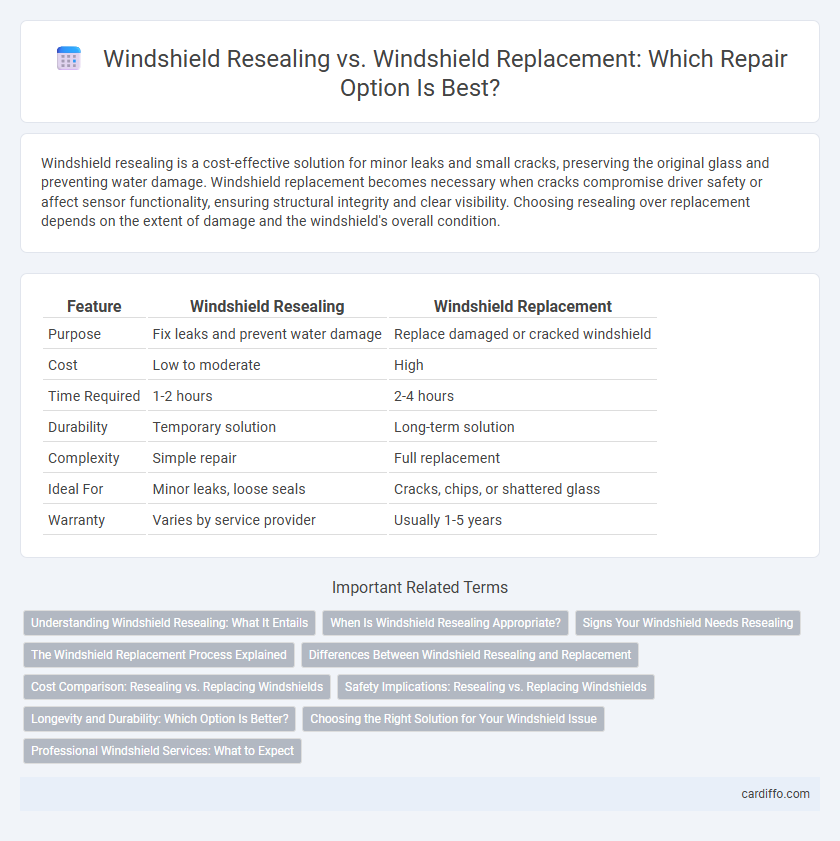Windshield resealing is a cost-effective solution for minor leaks and small cracks, preserving the original glass and preventing water damage. Windshield replacement becomes necessary when cracks compromise driver safety or affect sensor functionality, ensuring structural integrity and clear visibility. Choosing resealing over replacement depends on the extent of damage and the windshield's overall condition.
Table of Comparison
| Feature | Windshield Resealing | Windshield Replacement |
|---|---|---|
| Purpose | Fix leaks and prevent water damage | Replace damaged or cracked windshield |
| Cost | Low to moderate | High |
| Time Required | 1-2 hours | 2-4 hours |
| Durability | Temporary solution | Long-term solution |
| Complexity | Simple repair | Full replacement |
| Ideal For | Minor leaks, loose seals | Cracks, chips, or shattered glass |
| Warranty | Varies by service provider | Usually 1-5 years |
Understanding Windshield Resealing: What It Entails
Windshield resealing involves removing old sealant around the windshield perimeter and applying a fresh, high-quality adhesive to restore a watertight and secure bond between the glass and vehicle frame. This process is typically recommended for minor leaks, seal deterioration, or when the windshield retains structural integrity without cracks or chips. Proper windshield resealing helps prevent water damage, reduces wind noise, and maintains windshield stability without incurring the higher cost and complexity of a full windshield replacement.
When Is Windshield Resealing Appropriate?
Windshield resealing is appropriate when the glass itself is intact but the sealant has deteriorated, causing leaks or wind noise. This procedure is ideal for minor seal failures without structural damage, preserving the original windshield and reducing repair costs. However, resealing should only be attempted if there is no cracking, chipping, or delamination in the windshield glass.
Signs Your Windshield Needs Resealing
Visible water leaks around the windshield edges, fogging or moisture buildup inside the glass, and unusual wind noise while driving are key signs your windshield needs resealing. Warped or cracked sealant and loose or shifting glass can also indicate compromised seals threatening structural integrity. Addressing resealing early helps prevent costly windshield replacement and maintains vehicle safety.
The Windshield Replacement Process Explained
The windshield replacement process involves carefully removing the damaged glass, cleaning the frame, and applying a high-quality adhesive to ensure a secure seal. Technicians use precise tools to avoid damaging the vehicle's paint and ensure the replacement windshield fits perfectly. This process restores structural integrity and safety, making it essential over resealing when cracks or chips compromise the glass's strength.
Differences Between Windshield Resealing and Replacement
Windshield resealing involves applying a new sealant to fix minor leaks or gaps without removing the glass, typically preserving the original windshield and costing less. Windshield replacement requires removing the entire windshield due to severe damage or cracks, ensuring structural integrity but at a higher expense and longer repair time. The key difference lies in the extent of damage addressed, with resealing suitable for sealing issues and replacement necessary for compromised safety or visibility.
Cost Comparison: Resealing vs. Replacing Windshields
Windshield resealing typically costs between $50 and $150, offering a budget-friendly solution for minor leaks or seal damage. In contrast, windshield replacement ranges from $200 to $1,000, depending on vehicle make, model, and sensor technology integration. Choosing resealing can save significant expenses but may not be suitable for extensive damage requiring full replacement.
Safety Implications: Resealing vs. Replacing Windshields
Resealing a windshield can restore its water-tightness and prevent leaks but may not fully reinstate the original structural integrity critical during collisions. Windshield replacement ensures the adhesive bond meets factory safety standards, maintaining the vehicle's structural support and optimal airbag deployment. Choosing replacement over resealing significantly enhances passenger safety by preserving the windshield's role in crash protection.
Longevity and Durability: Which Option Is Better?
Windshield resealing preserves the original glass and frame, enhancing longevity by preventing water infiltration and maintaining structural integrity, whereas windshield replacement introduces a new glass panel that often provides superior durability against future cracks and chips. Resealing is typically effective for minor leaks or seal deterioration, supporting long-term performance if done promptly, but replacement is recommended when damage compromises the glass or adhesion, ensuring maximal lifespan. Evaluating the extent of damage and environmental exposure determines whether resealing or full replacement delivers better durability and lasting protection for vehicle safety.
Choosing the Right Solution for Your Windshield Issue
Windshield resealing is ideal for minor leaks and prevents water damage by restoring the seal between the glass and the vehicle frame, preserving the original windshield. Windshield replacement becomes necessary when cracks exceed six inches or visibility is impaired, ensuring structural integrity and safety are maintained. Evaluating damage severity and cost-effectiveness helps in choosing between resealing or full windshield replacement.
Professional Windshield Services: What to Expect
Professional windshield services begin with a thorough inspection to determine whether resealing or replacement is necessary based on the extent of damage and seal integrity. Windshield resealing involves expertly applying specialized sealants to restore the bond between glass and frame, preventing leaks and wind noise without compromising structural safety. Replacement includes precise removal of the damaged windshield and installing a new OEM or calibrated glass, ensuring optimal visibility, sensor functionality, and vehicle safety standards are maintained.
Windshield resealing vs Windshield replacement Infographic

 cardiffo.com
cardiffo.com